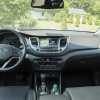Americans can’t seem to get enough crossovers. A study done by IHS Automotive showed that one out of every three vehicles sold in the U.S. is a crossover of some various size. Hence why it seems a week doesn’t go by without an announcement of a new crossover from ‘x’ automaker. One area that seems to have new or redesigned models coming fast and furious is the compact crossover class. New models are wanting to take a nice chunk of sales from the stalwarts such as the Honda CR-V, Subaru Forester, and Toyota RAV4. Whether it's with impressive handling characteristics (Mazda CX-5) or the availability to have three rows (Nissan Rogue), new models are beginning to take a stand on the sales chart.
Hyundai is the latest automaker to ready an attack on the old guard with the third-generation Tucson. The Korean automaker hopes the formula it has seemingly perfected over the past few years of great looks, an impressive feature set, and a low price tag can make the Tucson a contender in the class. I recently spent some time in Minneapolis and parts of Wisconsin driving the new Tucson to see if the model has a chance.
One of the key focuses for Hyundai on the 2016 Tucson was style. How do you make your model stand out in a crowded class? Hyundai decided to grace the 2016 Tucson with its Fluidic Sculpture 2.0 design language complete with sharp lines, hexagonal grille, and a set of slimmer head and taillights. One key design item Hyundai pointed out during the briefing was how the wheel arches were raked forward to promote the feeling of movement. I have to admit that Fluidic Sculpture 2.0 has been hit and miss on some of the Hyundai models. I think it works great on the Genesis as it gives it an identity, while it makes the Sonata quite boring. For the Tucson, it works very well. The model is very striking and at certain angles, reminds me of the Mazda CX-5.
The interior doesn’t have quite the same flair as the exterior, which is kind of a shame. But that doesn’t mean Hyundai left the interior as an afterthought. The design is simple with a wraparound dashboard and the use of contrasting materials. There is an equal mix of hard and soft-touch materials throughout, common for the class. Higher trims get a bit more soft-touch materials to make it feel more premium. In terms of standard equipment, the Tucson comes loaded. The base model boasts spilt-folding rear seats, a five-inch touchscreen radio, backup camera, and Bluetooth. Climb up to higher trims and features such as an eight-inch touchscreen with navigation, blind-spot monitoring, dual-zone climate control, heated and cooled front seats, and leather seats become available.
In terms of comfort, the Tucson scores well when it comes to passengers. The front seats have a fair amount of adjustment to get you into the right position, and also provide enough support for short and long trips. Back seat passengers will find a fair amount of head and legroom. The only disappointment in the Tucson’s interior is cargo space. Compared to the best-selling CR-V, the Tucson is 4.2 cubic feet smaller with the seats up (31 vs. 35.2) and 9 cubic feet smaller with the seats down (61.9 vs. 70.9).
For power, the Tucson comes with two engines. The base SE model uses the 2.0L GDI four-cylinder from the Elantra with 164 horsepower and 151 pound-feet of torque. This paired to a six-speed automatic. Front-wheel drive comes standard, though if you want all-wheel drive, you’ll need to order the SE Popular package. Eco and trims above it come with the turbocharged 1.6L four-cylinder found in the Sonata Eco. The 1.6 makes 175 horsepower and 195 pound-feet of torque. This comes paired with a seven-speed dual-clutch automatic and the choice of front or all-wheel drive. Fuel economy numbers for both engines are as followed:
- 2.0L FWD: 21 City/31 Highway/26 Combined
- 2.0L AWD: 21 City/26 Highway/ 23 Combined
- 1.6T FWD Eco: 26 City/33 Highway/29 Combined
- 1.6T AWD Eco: 25 City/31 Highway/27 Combined
- 1.6T FWD Sport/Limited: 25 City/30 Highway/27 Combined
- 1.6T AWD Sport/Limited: 24 City/28 Highway/26 Combined
Now the slight difference in fuel economy numbers between the Eco and Sport/Limited models mostly comes down to wheel size. The Eco comes with 17-inch wheels, while the Sport and Limited use 19-inch wheels.
Let’s move on to the drive.
Now before we dive into my impressions of the 2016 Tucson, I need to make note of something important. I didn’t get the chance to get behind the wheel of the Tucson equipped with the 2.0L engine. Hopefully in the future, I’ll be able to provide some impressions on that model.
Getting behind the wheel of the 1.6T, I found it to be a very potent engine. This is thanks in part to the 195 pound-feet of torque that arrives at 1,500 rpm and continues to 4,000 rpm. No matter when I needed to make a pass or merge onto the expressway, the engine was ready to get moving. Hyundai also deserves some credit for making the engine very quiet at idle. The seven-speed dual-clutch automatic did cause me some worry as I had an unpleasant experience in a Sonata Eco I drove a couple months back. The transmission in the Eco was very sloppy in its shift and seemed to be confused with the 1-2 shift. For the Tucson, Hyundai has made a number of improvements to the transmission to make the shifts much smoother. The difference is very apparent with the transmission delivering smooth and quick shifts.
As for ride and handling, the Tucson strikes a balance between sport and comfort. Hyundai has put a bit work into the suspension with a multi-link rear setup coming to all models - the last-generation Tucson used a single-link rear setup on the front-wheel drive model. The Tucson’s structure has also seen some improvements, with the body seeing a 48 percent bump in rigidity thanks to increasing the use of high-strength steel. Driving on a wide range of roads, the Tucson impressed in how it managed all manner of bumps and imperfections. The suspension was able to keep the impacts from reaching the passengers inside. More impressive was how quiet the Tucson was. Even on rough, gravel roads, the Tucson was able to keep road noise at a minimum.
The Tucson’s handling may be Hyundai’s best effort yet. The crossover feels planted and shows no sign of body roll when being pushed. The only downside is the steering has a dead-zone when you begin to turn the wheel. Some resistance does appear when you turn the wheel further. This will annoy some people, but many will not even notice it.
Pricing for the new the 2016 Hyundai Tucson begins at $23,595 for the base SE front-wheel drive (includes an $895 destination charge) and climbs to $34,945 for the Limited all-wheel drive equipped with the Ultimate package. Considering the amount of standard equipment for each trim level, the Tucson is quite the value.
The third-generation Hyundai Tucson looks be the model to take on the old-guard in the compact crossover class. The new Tucson does mostly everything a crossover should do, along with impressive exterior design, an extensive feature set, and a turbocharged engine that is punchy. It may be that the 2016 Hyundai Tucson can be considered one of the best in its class.
Disclaimer: Hyundai Invited Cheers & Gears To A National Launch for the Tucson.
Year: 2016
Make: Hyundai
Model: Tucson
Engine: 2.0L GDI DOHC Four-Cylinder, Turbocharged 1.6L GDI DOHC Four-Cylinder
Driveline: Front-Wheel Drive, All-Wheel Drive: Six-Speed Automatic, Seven-Speed Dual Clutch
Horsepower @ RPM: 164 @ 6,200 (2.0L); 175 @ 5,500 (1.6T)
Torque @ RPM: 151 @ 4,000 (2.0L); 195 @ 1,500-4,500 (1.6T)
Curb Weight: 3,325 to 3,710 lbs
Prices: $23,595 to $34,595 (Includes $895 destination charge)







-3707742431.jpg.06edf8e14f4ccf35c60d4774a543cc11.jpg)



Recommended Comments
Join the conversation
You can post now and register later. If you have an account, sign in now to post with your account.
Note: Your post will require moderator approval before it will be visible.